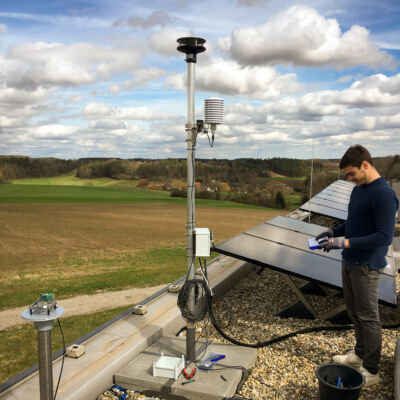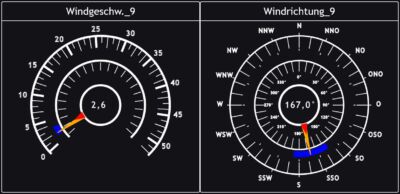Digital weatherman for the campus
Precise weather data for building services and drone flights

A professional weather station has been installed on the roof of the research hall at the Feuchtwangen campus for two weeks. Equipped with a large number of high-resolution sensors, numerous environmental data are available and can be used for teaching and research.
All measurement signals are digitized and written to a database at regular intervals by an integrated data logger. Current measured values can be called up live, partly graphically processed, on the dashboard of the internal web interface.
A combined instrument records temperature, relative humidity of the air and barometric pressure. From this, other variables such as the dew point as well as the current weather trend can be derived.
Precipitation is registered with the aid of a so-called tipping bucket rain gauge. The precipitation water collects below a funnel in a bucket, which tilts down and empties at a certain weight. The amount of precipitation can be calculated from the number of tipping movements. The tilting movements are detected electrically by a magnet on the tilting device and a reed contact fixed opposite.



An ultrasonic anemometer is used to determine wind speed and wind direction. This very robust and compact sensor has no moving parts and is particularly suitable for high wind speeds. The integrated heating also prevents icing during the winter time.
The irradiance of the sun (so-called global radiation in watts per square meter) is measured with a pyranometer. Solar radiation is absorbed in a thermopile, converted into heat and output as a proportional voltage signal.
Weather data such as air temperature, humidity, dew point, wind speed, wind direction and global radiation can be used in many ways. Both current measured values and long-term measurements can be used, for example, for building simulations. In addition, it is possible to create and visualize site-specific annual, monthly or weekly comparisons. Furthermore, the current global radiation can be used as a reference variable, e.g. for charging an e-car or a stationary battery storage.
Current weather data is also of great importance for the pilots of the Bavarian Drone Academy. Before flying a drone, every remote pilot is required to check the current weather conditions. Apps such as “UAV-Forecast” or “DWD-Flugwetter” as well as relevant websites are usually used for this purpose. In the future, one look will be enough to quickly and reliably inform oneself about the actual weather conditions currently available on site.
